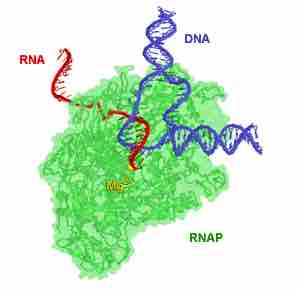Antimicrobial drugs can target nucleic acid (either RNA or DNA) synthesis. The antimicrobial actions of these agents are a result of differences in prokaryotic and eukaryotic enzymes involved in nucleic acid synthesis.
Prokaryotic transcription is the process in which messenger RNA transcripts of genetic material are produced for later translation into proteins. The transcription process includes the following steps: initiation, elongation and termination . Antimicrobial drugs have been developed to target each of these steps. For example, the antimicrobial rifampin binds to DNA-dependent RNA polymerase, thereby inhibiting the initiation of RNA transcription.

Diagram of Transcription
RNA Polymerase, an enzyme that produces RNA, from T. aquaticus pictured during elongation. Portions of the enzyme were made transparent so as to make the path of RNA and DNA more clear. The magnesium ion (yellow) is located at the enzyme active site.
Other antimicrobial drugs interfere with DNA replication, the biological process that occurs in all living organisms and copies their DNA and is the basis for biological inheritance. The process starts when one double-stranded DNA molecule produces two identical copies of the molecule . In a cell, DNA replication begins at specific locations in the genome, called "origins. " Uncoiling of DNA at the origin, and synthesis of new strands, forms a replication fork. In addition to DNA polymerase, the enzyme that synthesizes the new DNA by adding nucleotides matched to the template strand, a number of other proteins are associated with the fork and assist in the initiation and continuation of DNA synthesis. DNA replication, like all biological polymerization processes, proceeds in three enzymatically catalyzed and coordinated steps: initiation, elongation and termination. Any of the steps in the process of DNA replication can be targeted by antimicrobial drugs. For instance, quinolones inhibit DNA synthesis by interfering with the coiling of DNA strands.

DNA Replication
The double helix is unwound and each strand acts as a template for the next strand. Bases are matched to synthesize the new partner strands.